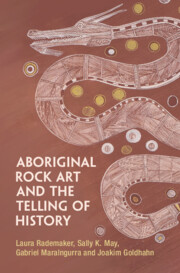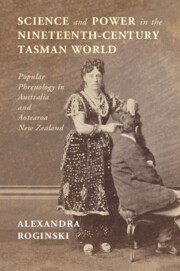92 results
1 - Aboriginal pedagogies: exploring Indigenous ways of knowing, being and doing
- from Part 1 - Pedagogies for all
-
-
- Book:
- Teaching to Transform Learning
- Published online:
- 25 October 2024
- Print publication:
- 05 December 2024, pp 12-29
-
- Chapter
- Export citation
11 - Exclusion and Inclusion in Australian Metal
- from Part III - Diversities
-
-
- Book:
- The Cambridge Companion to Music in Australia
- Published online:
- 14 November 2024
- Print publication:
- 14 November 2024, pp 173-187
-
- Chapter
- Export citation

Aboriginal Rock Art and the Telling of History
-
- Published online:
- 12 November 2024
- Print publication:
- 05 December 2024
Archaeology on the edge: radiocarbon chronologies for Aboriginal cliff-top sites of the Murray River, South Australia
-
- Journal:
- Radiocarbon / Volume 67 / Issue 1 / February 2025
- Published online by Cambridge University Press:
- 05 November 2024, pp. 200-214
- Print publication:
- February 2025
-
- Article
-
- You have access
- Open access
- HTML
- Export citation
3 - Two worlds, one culture
- from Part 1
-
-
- Book:
- Young Children and the Environment
- Published online:
- 05 January 2024
- Print publication:
- 05 January 2024, pp 53-70
-
- Chapter
- Export citation
3 - Tactics on Stage: Indigenous Performers, Cultural Exchange and Negotiated Power
-
- Book:
- Science and Power in the Nineteenth-Century Tasman World
- Published online:
- 18 May 2023
- Print publication:
- 01 June 2023, pp 80-106
-
- Chapter
- Export citation
5 - Talking Heads on a Murray River Mission
-
- Book:
- Science and Power in the Nineteenth-Century Tasman World
- Published online:
- 18 May 2023
- Print publication:
- 01 June 2023, pp 126-147
-
- Chapter
- Export citation
Chapter 23 - Forensic Aspects of Neurodevelopmental Disorders: An Australasian Perspective
- from Section 3 - Criminal Justice Pathways and Legal Issues
-
-
- Book:
- Forensic Aspects of Neurodevelopmental Disorders
- Published online:
- 18 May 2023
- Print publication:
- 01 June 2023, pp 277-299
-
- Chapter
- Export citation

Science and Power in the Nineteenth-Century Tasman World
- Popular Phrenology in Australia and Aotearoa New Zealand
-
- Published online:
- 18 May 2023
- Print publication:
- 01 June 2023
20 - Genocide in Van Diemen’s Land (Tasmania), 1803–1871
- from Part III - Nineteenth-Century Frontier Genocides
-
-
- Book:
- The Cambridge World History of Genocide
- Published online:
- 23 June 2023
- Print publication:
- 04 May 2023, pp 481-507
-
- Chapter
- Export citation
2 - A Very British Genocide
- from Part I - Settler Colonialism
-
-
- Book:
- The Cambridge World History of Genocide
- Published online:
- 23 June 2023
- Print publication:
- 04 May 2023, pp 46-68
-
- Chapter
- Export citation
5 - Diachronic Toponymy
-
- Book:
- Place Names
- Published online:
- 02 March 2023
- Print publication:
- 09 March 2023, pp 114-133
-
- Chapter
- Export citation
2 - Plural Legal Orders: Concept and Practice
- from I - Cultures of Law
-
-
- Book:
- The Cambridge Legal History of Australia
- Published online:
- 04 August 2022
- Print publication:
- 18 August 2022, pp 19-39
-
- Chapter
- Export citation
Applying an authentic partnership approach to facilitate optimal health of Aboriginal children
-
- Journal:
- Primary Health Care Research & Development / Volume 23 / 2022
- Published online by Cambridge University Press:
- 15 August 2022, e47
-
- Article
-
- You have access
- Open access
- HTML
- Export citation
Understanding and working with different worldviews to co-design cultural security in clinical mental health settings to engage with Aboriginal and Torres Strait Islander clients
- Part of
-
- Journal:
- Primary Health Care Research & Development / Volume 22 / 2021
- Published online by Cambridge University Press:
- 29 October 2021, e59
-
- Article
-
- You have access
- Open access
- HTML
- Export citation
Building Indigenous health workforce capacity and capability through leadership – the Miwatj health leadership model
- Part of
-
- Journal:
- Primary Health Care Research & Development / Volume 22 / 2021
- Published online by Cambridge University Press:
- 07 October 2021, e52
-
- Article
-
- You have access
- Open access
- HTML
- Export citation
The development of aboriginal brain injury coordinator positions: a culturally secure rehabilitation service initiative as part of a clinical trial
- Part of
-
- Journal:
- Primary Health Care Research & Development / Volume 22 / 2021
- Published online by Cambridge University Press:
- 29 September 2021, e49
-
- Article
-
- You have access
- Open access
- HTML
- Export citation
5 - Indigenous gendered health perspectives
-
-
- Book:
- Yatdjuligin
- Published online:
- 16 August 2021
- Print publication:
- 25 August 2021, pp 104-120
-
- Chapter
- Export citation
15 - Indigenous child health
-
-
- Book:
- Yatdjuligin
- Published online:
- 16 August 2021
- Print publication:
- 25 August 2021, pp 330-353
-
- Chapter
- Export citation
9 - Remote area nursing practice
-
-
- Book:
- Yatdjuligin
- Published online:
- 16 August 2021
- Print publication:
- 25 August 2021, pp 187-206
-
- Chapter
- Export citation


